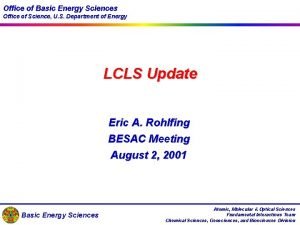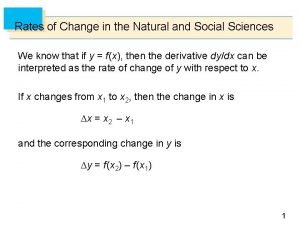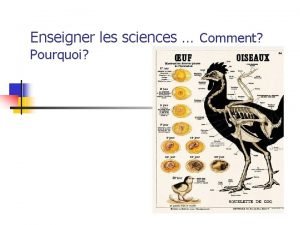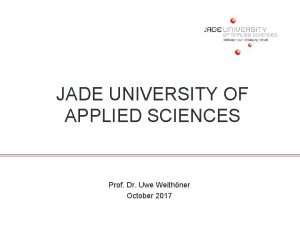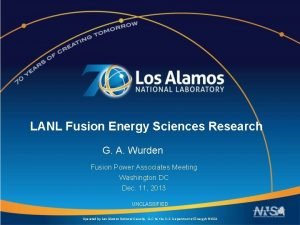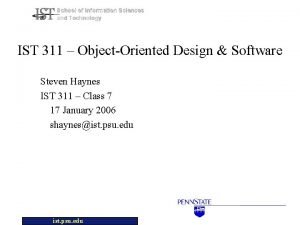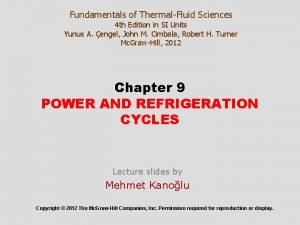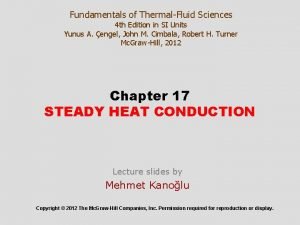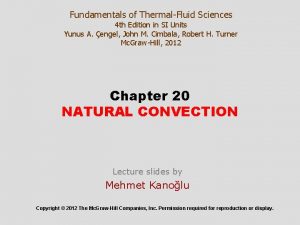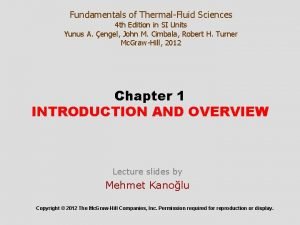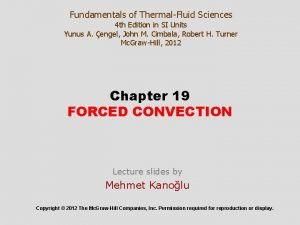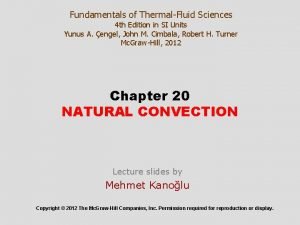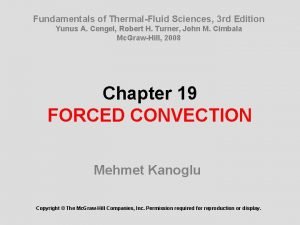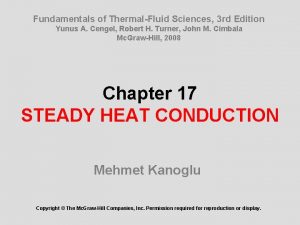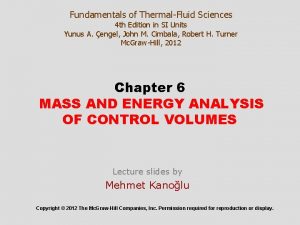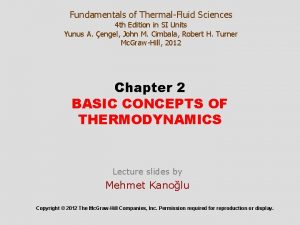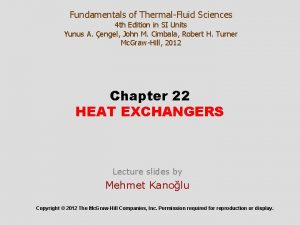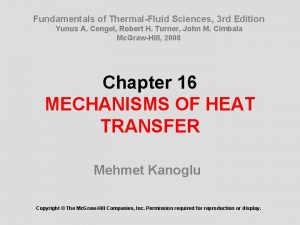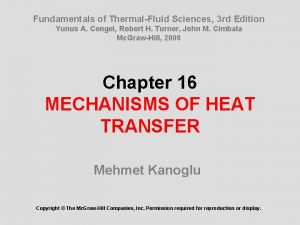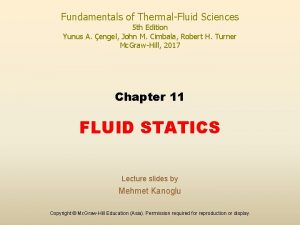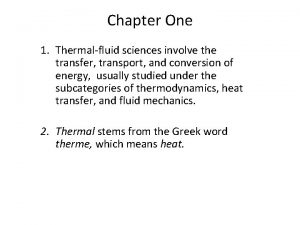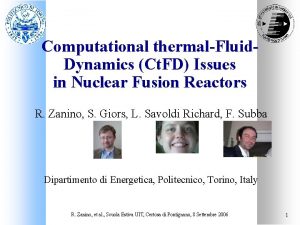Fundamentals of ThermalFluid Sciences 4 th Edition in




















































- Slides: 52

Fundamentals of Thermal-Fluid Sciences 4 th Edition in SI Units Yunus A. Çengel, John M. Cimbala, Robert H. Turner Mc. Graw-Hill, 2012 Chapter 21 RADIATION HEAT TRANSFER Lecture slides by Mehmet Kanoğlu Copyright © 2012 The Mc. Graw-Hill Companies, Inc. Permission required for reproduction or display.

Objectives • Classify electromagnetic radiation, and identify thermal radiation • Understand the idealized blackbody, and calculate the total and spectral blackbody emissive power • Calculate the fraction of radiation emitted in a specified wavelength band using the blackbody radiation functions • Develop a clear understanding of the properties emissivity, absorptivity, reflectivity, and transmissivity on spectral and total basis • Apply Kirchhoff law’s to determine the absorptivity of a surface when its emissivity is known • Define view factor, and understand its importance in radiation heat transfer calculations • Calculate radiation heat transfer between black surfaces • Obtain relations for net rate of radiation heat transfer between the surfaces of a two-zone enclosure, including two large parallel plates, two long concentric cylinders, and two concentric spheres • Understand radiation heat transfer in three-surface enclosures 2

21 -1 INTRODUCTION The hot object in vacuum chamber will eventually cool down and reach thermal equilibrium with its surroundings by a heat transfer mechanism: radiation. Radiation differs from conduction and convection in that it does not require the presence of a material medium to take place. Radiation transfer occurs in solids as well as liquids and gases. 3

Accelerated charges or changing electric currents give rise to electric and magnetic fields. These rapidly moving fields are called electromagnetic waves or electromagnetic radiation, and they represent the energy emitted by matter as a result of the changes in the electronic configurations of the atoms or molecules. Electromagnetic waves transport energy just like other waves and they are characterized by their frequency or wavelength . These two properties in a medium are related by c = c 0 /n c, the speed of propagation of a wave in that medium c 0 = 2. 9979 108 m/s, the speed of light in a vacuum n, the index of refraction of that medium n =1 for air and most gases, n = 1. 5 for glass, and n = 1. 33 for water It has proven useful to view electromagnetic radiation as the propagation of a collection of discrete packets of energy called photons or quanta. In this view, each photon of frequency n is considered to have an energy of The energy of a photon is inversely proportional to its wavelength. 4

21 -2 THERMAL RADIATION The type of electromagnetic radiation that is pertinent to heat transfer is thermal radiation emitted as a result of energy transitions of molecules, atoms, and electrons of a substance. Temperature is a measure of the strength of these activities at the microscopic level, and the rate of thermal radiation emission increases with increasing temperature. Thermal radiation is continuously emitted by all matter whose temperature is above absolute zero. Everything around us constantly emits thermal radiation. The electromagnetic wave spectrum. 5

Light is simply the visible portion of the electromagnetic spectrum that lies between 0. 40 and 0. 76 m. A body that emits some radiation in the visible range is called a light source. The sun is our primary light source. The electromagnetic radiation emitted by the sun is known as solar radiation, and nearly all of it falls into the wavelength band 0. 3– 3 m. Almost half of solar radiation is light (i. e. , it falls into the visible range), with the remaining being ultraviolet and infrared. The radiation emitted by bodies at room temperature falls into the infrared region of the spectrum, which extends from 0. 76 to 100 m. The ultraviolet radiation includes the low-wavelength end of thermal radiation spectrum and lies between the wavelengths 0. 01 and 0. 40 m. Ultraviolet rays are to be avoided since they can kill microorganisms and cause serious damage to humans and other living beings. About 12 percent of solar radiation is in the ultraviolet range. The ozone (O 3) layer in the atmosphere acts as a protective blanket and absorbs most of this ultraviolet radiation. 6

In heat transfer studies, we are interested in the energy emitted by bodies because of their temperature only. Therefore, we limit our consideration to thermal radiation. The electrons, atoms, and molecules of all solids, liquids, and gases above absolute zero temperature are constantly in motion, and thus radiation is constantly emitted, as well as being absorbed or transmitted throughout the entire volume of matter. That is, radiation is a volumetric phenomenon. 7

21 -3 BLACKBODY RADIATION • • • Different bodies may emit different amounts of radiation per unit surface area. A blackbody emits the maximum amount of radiation by a surface at a given temperature. It is an idealized body to serve as a standard against which the radiative properties of real surfaces may be compared. A blackbody is a perfect emitter and absorber of radiation. A blackbody absorbs all incident radiation, regardless of wavelength and direction. The radiation energy emitted by a blackbody: Blackbody emissive power Stefan–Boltzmann constant 8

Spectral blackbody emissive Power: The amount of radiation energy emitted by a blackbody at a thermodynamic temperature T per unit time, per unit surface area, and per unit wavelength about the wavelength . Planck’s law Boltzmann’s constant 9

The wavelength at which the peak occurs for a specified temperature is given by Wien’s displacement law: 10

Observations from the figure • The emitted radiation is a continuous function of wavelength. At any specified temperature, it increases with wavelength, reaches a peak, and then decreases with increasing wavelength. • At any wavelength, the amount of emitted radiation increases with increasing temperature. • As temperature increases, the curves shift to the left to the shorter wavelength region. Consequently, a larger fraction of the radiation is emitted at shorter wavelengths at higher temperatures. • The radiation emitted by the sun, which is considered to be a blackbody at 5780 K (or roughly at 5800 K), reaches its peak in the visible region of the spectrum. Therefore, the sun is in tune with our eyes. • On the other hand, surfaces at T < 800 K emit almost entirely in the infrared region and thus are not visible to the eye unless they reflect light coming from other sources. 11

12

The radiation energy emitted by a blackbody per unit area over a wavelength band from = 0 to is Blackbody radiation function f : The fraction of radiation emitted from a blackbody at temperature T in the wavelength band from = 0 to . 13


15

21 -4 RADIATIVE PROPERTIES Most materials encountered in practice, such as metals, wood, and bricks, are opaque to thermal radiation, and radiation is considered to be a surface phenomenon for such materials. Radiation through semitransparent materials such as glass and water cannot be considered to be a surface phenomenon since the entire volume of the material interacts with radiation. A blackbody can serve as a convenient reference in describing the emission and absorption characteristics of real surfaces. 16

Emissivity • Emissivity: The ratio of the radiation emitted by the surface at a given temperature to the radiation emitted by a blackbody at the same temperature. 0 1. • Emissivity is a measure of how closely a surface approximates a blackbody ( = 1). • The emissivity of a real surface varies with the temperature of the surface as well as the wavelength and the direction of the emitted radiation. • The emissivity of a surface at a specified wavelength is called spectral emissivity . The emissivity in a specified direction is called directional emissivity where is the angle between the direction of radiation and the normal of the surface. spectral hemispherical emissivity total hemispherical emissivity The ratio of the total radiation energy emitted by the surface to the radiation emitted by a blackbody of the same surface area at the same temperature

18

A surface is said to be diffuse if its properties are independent of direction, and gray if its properties are independent of wavelength. The gray and diffuse approximations are often utilized in radiation calculations. is the angle measured from the normal of the surface 19

20

The variation of normal emissivity with (a) wavelength and (b) temperature for various materials. In radiation analysis, it is common practice to assume the surfaces to be diffuse emitters with an emissivity equal to the value in the normal ( = 0) direction. Typical ranges of emissivity for various materials. 21

Irradiation, G: Radiation flux incident on a surface. Absorptivity, Reflectivity, and Transmissivity for opaque surfaces 22

spectral hemispherical absorptivity spectral hemispherical reflectivity spectral hemispherical transmissivity spectral directional absorptivity spectral directional reflectivity G : the spectral irradiation, W/m 2 m Average absorptivity, reflectivity, and transmissivity of a surface: 23

In practice, surfaces are assumed to reflect in a perfectly specular or diffuse manner. Specular (or mirrorlike) reflection: The angle of reflection equals the angle of incidence of the radiation beam. Diffuse reflection: Radiation is reflected equally in all directions. 24

Kirchhoff’s Law Kirchhoff’s law The total hemispherical emissivity of a surface at temperature T is equal to its total hemispherical absorptivity for radiation coming from a blackbody at the same temperature. spectral form of Kirchhoff’s law The emissivity of a surface at a specified wavelength, direction, and temperature is always equal to its absorptivity 25 at the same wavelength, direction, and temperature.

The Greenhouse Effect Glass has a transparent window in the wavelength range 0. 3 m < < 3 m in which over 90% of solar radiation is emitted. The entire radiation emitted by surfaces at room temperature falls in the infrared region ( > 3 m). Glass allows the solar radiation to enter but does not allow the infrared radiation from the interior surfaces to escape. This causes a rise in the interior temperature as a result of the energy buildup in the car. This heating effect, which is due to the nongray characteristic of glass (or clear plastics), is known as the greenhouse effect. 26

21 -5 THE VIEW FACTOR View factor is a purely geometric quantity and is independent of the surface properties and temperature. It is also called the shape factor, configuration factor, and angle factor. The view factor based on the assumption that the surfaces are diffuse emitters and diffuse reflectors is called the diffuse view factor, and the view factor based on the assumption that the surfaces are diffuse emitters but specular reflectors is called the specular view factor. Fij the fraction of the radiation leaving surface i that strikes surface j directly The view factor ranges between 0 and 1. 27

28

The view factor has proven to be very useful in radiation analysis because it allows us to express the fraction of radiation leaving a surface that strikes another surface in terms of the orientation of these two surfaces relative to each other. The underlying assumption in this process is that the radiation a surface receives from a source is directly proportional to the angle the surface subtends when viewed from the source. This would be the case only if the radiation coming off the source is uniform in all directions throughout its surface and the medium between the surfaces does not absorb, emit, or scatter radiation. That is, it is the case when the surfaces are isothermal and diffuse emitters and reflectors and the surfaces are separated by a nonparticipating medium such as a vacuum or air. View factors for hundreds of common geometries are evaluated and the results are given in analytical, graphical, and tabular form. 29

30

31

32

View factor between two aligned parallel rectangles of equal size. 33

View factor between two perpendicular rectangles with a common edge. 34

View factor between two coaxial parallel disks. 35

View factors for two concentric cylinders of finite length: (a) outer cylinder to inner cylinder; (b) outer cylinder to itself. 36

View Factor Relations Radiation analysis on an enclosure consisting of N surfaces requires the evaluation of N 2 view factors. Once a sufficient number of view factors are available, the rest of them can be determined by utilizing some fundamental relations for view factors. 1 The Reciprocity Relation reciprocity relation (rule) 37

2 The Summation Rule The sum of the view factors from surface i of an enclosure to all surfaces of the enclosure, including to itself, must equal unity. The total number of view factors that need to be evaluated directly for an N-surface enclosure is The remaining view factors can be determined from the equations that are obtained by applying the reciprocity and the summation rules. 38

3 The Superposition Rule The view factor from a surface i to a surface j is equal to the sum of the view factors from surface i to the parts of surface j. multiply by A 1 apply the reciprocity relation 39

4 The Symmetry Rule Two (or more) surfaces that possess symmetry about a third surface will have identical view factors from that surface. If the surfaces j and k are symmetric about the surface i then Fi j = Fi k and Fj i = Fk i 40

View Factors between Infinitely Long Surfaces: The Crossed-Strings Method Channels and ducts that are very long in one direction relative to the other directions can be considered to be two-dimensional. These geometries can be modeled as being infinitely long, and the view factor between their surfaces can be determined by simple crossedstrings method. 41

21 -6 RADIATION HEAT TRANSFER: BLACK SURFACES When the surfaces involved can be approximated as blackbodies because of the absence of reflection, the net rate of radiation heat transfer from surface 1 to surface 2 is reciprocity relation emissive power A negative value for Q 1 → 2 indicates that net radiation heat transfer is from surface 2 to surface 1. The net radiation heat transfer from any surface i of an N surface enclosure is 42

21 -7 RADIATION HEAT TRANSFER: DIFFUSE, GRAY SURFACES • Most enclosures encountered in practice involve nonblack surfaces, which allow multiple reflections to occur. • Radiation analysis of such enclosures becomes very complicated unless some simplifying assumptions are made. • It is common to assume the surfaces of an enclosure to be opaque, diffuse, and gray. • Also, each surface of the enclosure is isothermal, and both the incoming and outgoing radiation are uniform over each surface. 43

Radiosity For a surface i that is gray and opaque ( i = � i and � i + i = 1) Radiosity J: The total radiation energy leaving a surface per unit time and per unit area. For a blackbody = 1 The radiosity of a blackbody is equal to its emissive power since radiation coming from a blackbody is due to emission only. 44

Net Radiation Heat Transfer to or from a Surface The net rate of radiation heat transfer from a surface i surface resistance to radiation. The surface resistance to radiation for a blackbody is zero since i = 1 and Ji = Ebi. Reradiating surface: Some surfaces are modeled as being adiabatic since their back sides are well insulated and the net heat transfer through them is zero. 45

Net Radiation Heat Transfer between Any Two Surfaces The net rate of radiation heat transfer from surface i to surface j is Apply the reciprocity relation space resistance to radiation 46

In an N-surface enclosure, the conservation of energy principle requires that the net heat transfer from surface i be equal to the sum of the net heat transfers from surface i to each of the N surfaces of the enclosure. The net radiation flow from a surface through its surface resistance is equal to the sum of the radiation flows from that surface to all other surfaces through the corresponding space resistances. 47

Methods of Solving Radiation Problems In the radiation analysis of an enclosure, either the temperature or the net rate of heat transfer must be given for each of the surfaces to obtain a unique solution for the unknown surface temperatures and heat transfer rates. The equations above give N linear algebraic equations for the determination of the N unknown radiosities for an N-surface enclosure. Once the radiosities J 1, J 2, . . . , JN are available, the unknown heat transfer rates and the unknown surface temperatures can be determined from the above equations. Direct method: Based on using the above procedure. This method is suitable when there a large number of surfaces. Network method: Based on the electrical network analogy. Draw a surface resistance associated with each surface of an enclosure and connect them with space resistances. Then solve the radiation problem by treating it as an electrical network problem. The network method is not practical for enclosures with more than three or four surfaces. 48

Radiation Heat Transfer in Two-Surface Enclosures This important result is applicable to any two gray, diffuse, and opaque surfaces that form an enclosure. 49

50

Radiation Heat Transfer in Three. Surface Enclosures When Qi is specified at surface i instead of the temperature, the term (Ebi − Ji)/Ri should be replaced by the specified Qi. The algebraic sum of the currents (net radiation heat transfer) at each node must equal zero. These equations are to be solved for J 1, J 2, and J 3. Draw a surface resistance associated with each of the three surfaces and connect them with space resistances. Schematic of a three-surface enclosure and the radiation network 51 associated with it.

Summary • Thermal Radiation • Blackbody Radiation • Radiative Properties ü ü Emissivity Absorptivity, Reflectivity, and Transmissivity Kirchhoff’s Law The Greenhouse Effect • The View Factor • Radiation Heat Transfer: Black Surfaces • Radiation Heat Transfer: Diffuse, Gray Surfaces ü ü ü Radiosity Net Radiation Heat Transfer to or from a Surface Net Radiation Heat Transfer between Any Two Surfaces Methods of Solving Radiation Problems Radiation Heat Transfer in Two-Surface Enclosures Radiation Heat Transfer in Three-Surface Enclosures 52
 Human sciences
Human sciences Fundamentals of corporate finance 3rd canadian edition
Fundamentals of corporate finance 3rd canadian edition Thermal resistance formula
Thermal resistance formula Fundamentals of information systems 9th edition
Fundamentals of information systems 9th edition Computer security fundamentals 4th edition
Computer security fundamentals 4th edition Machining fundamentals 10th edition
Machining fundamentals 10th edition Corporate finance 6th edition
Corporate finance 6th edition Digital fundamentals 10th edition
Digital fundamentals 10th edition The fundamentals of political science research 2nd edition
The fundamentals of political science research 2nd edition Fundamentals of information systems 9th edition
Fundamentals of information systems 9th edition Management fundamentals 8th edition
Management fundamentals 8th edition Fundamentals of organizational communication
Fundamentals of organizational communication Abnormal psychology ronald j comer 9th edition
Abnormal psychology ronald j comer 9th edition Digital fundamentals by floyd
Digital fundamentals by floyd Fluid mechanics fundamentals and applications 3rd edition
Fluid mechanics fundamentals and applications 3rd edition Fundamentals of corporate finance third canadian edition
Fundamentals of corporate finance third canadian edition Fundamentals of information systems
Fundamentals of information systems Fundamentals of organizational communication 9th edition
Fundamentals of organizational communication 9th edition Fundamentals of information systems 9th edition
Fundamentals of information systems 9th edition Dc/ac fundamentals a systems approach
Dc/ac fundamentals a systems approach Digital fundamentals tenth edition floyd
Digital fundamentals tenth edition floyd Fundamentals of corporate finance fifth edition
Fundamentals of corporate finance fifth edition Using mis 10th edition
Using mis 10th edition Report
Report Office of basic energy sciences
Office of basic energy sciences University of kragujevac faculty of technical sciences
University of kragujevac faculty of technical sciences Mrbs scholarship
Mrbs scholarship Managerial economics and decision sciences
Managerial economics and decision sciences Scientific method in social sciences
Scientific method in social sciences Phi sigma biological sciences honor society
Phi sigma biological sciences honor society Ucsf global health sciences
Ucsf global health sciences Data integration in the life sciences
Data integration in the life sciences Innovation that matters ibm
Innovation that matters ibm Rates of change in the natural and social sciences
Rates of change in the natural and social sciences Vaasa university of applied sciences
Vaasa university of applied sciences Leçon de sciences
Leçon de sciences Master sciences analytiques pour les bioindustries
Master sciences analytiques pour les bioindustries Academy of motion picture arts and sciences benefits
Academy of motion picture arts and sciences benefits Fusion energy sciences
Fusion energy sciences Jade university of applied sciences
Jade university of applied sciences Cleveland arts and social sciences academy
Cleveland arts and social sciences academy Dentistry & oral sciences source
Dentistry & oral sciences source Western norway university of applied sciences
Western norway university of applied sciences Fusion energy sciences
Fusion energy sciences Social sciences examples
Social sciences examples Kafue institute of health sciences
Kafue institute of health sciences Energy system grade 7
Energy system grade 7 Sakarya university master programs
Sakarya university master programs Hawaii academy of arts and science
Hawaii academy of arts and science Ist 311
Ist 311 Observational health data sciences and informatics
Observational health data sciences and informatics Uzbek academy of sciences
Uzbek academy of sciences Uf premed advising
Uf premed advising
























